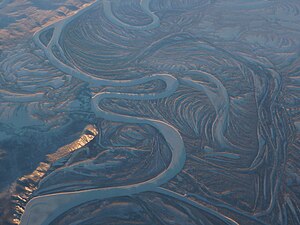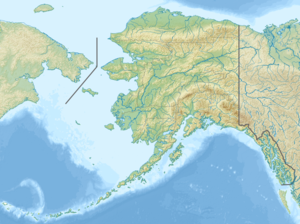Koyukuk National Wildlife Refuge
| Koyukuk National Wildlife Refuge | |
|---|---|
|
IUCN category IV (habitat/species management area)
|
|

Aerial view of the lower Koyukuk River floodplain
|
|
|
Map of Alaska, United States
|
|
| Location | Alaska, United States |
| Nearest city | Galena, Alaska |
| Coordinates | 65°35′00″N 157°14′26″W / 65.5833333°N 157.2405556°WCoordinates: 65°35′00″N 157°14′26″W / 65.5833333°N 157.2405556°W |
| Area | 3,500,000 acres (14,000 km2) |
| Established | 1980 |
| Governing body | U.S. Fish and Wildlife Service |
| Website | Koyukuk NWR |
The Koyukuk National Wildlife Refuge is a 3,500,000-acre (14,000 km2) conservation area in Alaska. It lies within the floodplain of the Koyukuk River, in a basin that extends from the Yukon River to the Purcell Mountains and the foothills of the Brooks Range. This region of wetlands is home to fish, waterfowl, beaver and Alaskan moose, and wooded lowlands where two species of fox, bears, wolf packs, Canadian lynx and marten prowl.
The 750,000-acre (3,000 km2) Northern Unit of the Innoko National Wildlife Refuge, commonly known as Kaiyuh Flats, is managed as part of the Koyukuk/Nowitna Refuge Complex. Rich in wetlands, the Northern Innoko is an extremely productive breeding area for migratory waterfowl and fish. The streams and rivers of the refuge complex support three species of salmon, Arctic grayling, sheefish, and many other fish species. Northern pike, especially those that winter in the shallow lakes of the Northern Innoko National Wildlife Refuge, sometimes grow to record size.
In the Koyukuk's wetlands, breeding waterfowl feast upon water plants and abundant protein-rich invertebrates. Young birds grow quickly in the short, lush summer, and prepare for the fall migration. As many as 100,000 ducks are hatched and raised on refuge lands during a single nesting season. Migratory songbirds and raptors also depend on the rich resources of the Koyukuk Refuge for breeding and raising young.
...
Wikipedia

